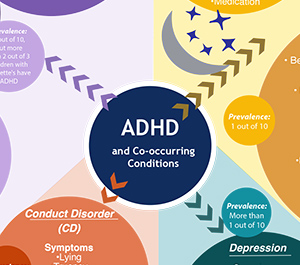A co-morbid condition is a condition that lives alongside another condition in the same person. Even though this isn’t a very cheerful term, but in simple terms you have two or more medical conditions at the same time such as depression or bipolar disorder. There is a saying that ‘ADHD rarely travels alone”, which means any condition can co-exist with ADHD, but certain conditions are more commonly associated with ADHD. Now that you have some general backgrounds about co-existing conditions, let’s look at ADHD and co-existing conditions.
Learning Disabilities Many women with ADHD have a learning disabilities. In addition to the symptoms of ADHD, such as difficulties paying attention, staying on task, or being organized. Having a learning disorder means that a women has a clear difficulty in one or more areas of learning, even when their intelligence is not affected. Learning disorders include, Dyslexia – difficulty with reading, Dyscalculia – difficulty with math, Dysgraphia – difficulty with writing
Anxiety- Many women with ADHD have fears and worries. However, when a women experiences so many fears and worries that they interfere with their daily activities. it is an anxiety disorder. Examples of anxiety disorders include. Separation anxiety – being very afraid when they are away from family, Social anxiety – being very afraid of school and other places where they may meet people, General anxiety – being very worried about the future and about bad things happening to them.
Depression – Occasionally being sad or feeling hopeless can be a part of a women with ADHD life. When a women feels persistent sadness and hopelessness, it can cause problems. A women may be more likely to feel hopeless and sad when they can’t control their ADHD symptoms and the symptoms interfere with their daily activities. Examples of behaviors often seen in a women are depressed include, Feeling sad or hopeless a lot of the time, Not wanting to do things that are funHaving a hard time focusing & Feeling worthless or useless
Bipolar Disorder – It is estimated that around 20% of women with ADHD also have Bipolar disorder (BPD) On the surface, the ADHD and Bipolar disorder (BPD) share some similar symptoms, such as impulsivity, racing thoughts, and rapid mood swings. However, those symptoms play out differently with each condition. Examples of behaviors that are often seen in women who have bipolar. Mood swings from calm to rage and/or from depression to manic (super-happy) state, difficulty relaxing, mood shifts come and go without any connection to the outside world, and are sustained for a long period of time & excessive talking
Sleep difficulties -There is a various of sleep disorders that are common in women with ADHD., including sleep apnea, restless leg syndrome, and teeth grinding. Women with ADHD also find it hard to fall asleep, stay asleep and wake up. Sleep problems can be an unofficial symptom of ADHD, and it’s a catch-22 because lack of sleep makes symptoms of ADHD worse. Common sleep problems in a women with ADHD could include insomnia , anxiety, sleep onset association, & deep sleep phase
In closing, for a women with ADHD the challenge of having another c0-condition is that they can mask each other, making diagnosing, management, and treatment trickier. Receiving a co-condition diagnosis can cause a roller coaster of emotions These emotions often intensify when you discover you have additional conditions. Remember, you are much more than the conditions you have been diagnosed with, they are part of who you are, but not all of you.
